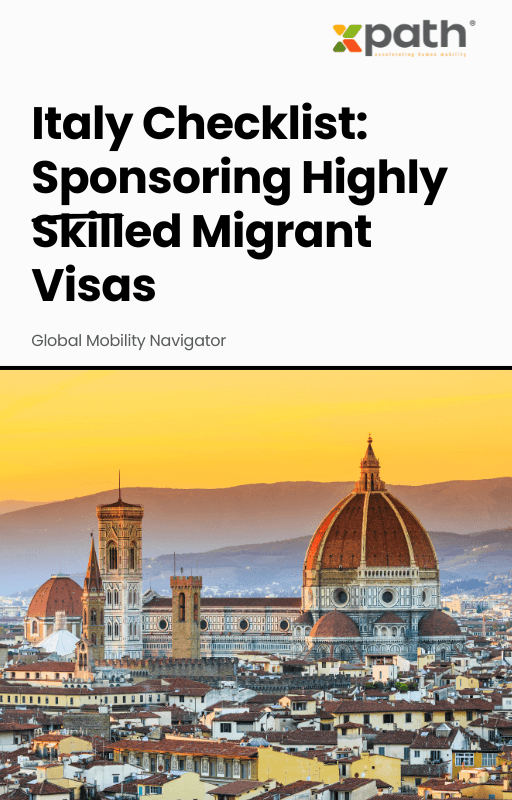Italy Checklist: Sponsoring Highly Skilled Migrant Visas
Grab a copy of a guide to international employee relocation
View E-bookBusinesses no longer compete locally—they compete globally. This shift demands a workforce that transcends geographical, cultural, and linguistic boundaries. However, managing talent across diverse regions presents unique challenges, from navigating cultural nuances to complying with varying labor laws. The secret to better global talent management isn’t a single tactic but a holistic strategy that prioritizes adaptability, empathy, and innovation. Here’s how organizations can thrive in the era of borderless talent.
Globalization has opened doors to unprecedented talent pools, but it also introduces complexity. Companies face:
Cultural Misalignment: Differing work ethics, communication styles, and expectations can lead to friction.
Regulatory Hurdles: Compliance with local labor laws, tax codes, and data privacy regulations requires meticulous planning.
Talent Retention: Remote and hybrid models have raised expectations for flexibility, growth, and purpose-driven work.
Skill Gaps: Rapid technological advancements demand continuous upskilling to stay competitive.
To overcome these hurdles, organizations must rethink traditional HR frameworks and adopt strategies tailored to a globalized workforce.
Cultural intelligence—the ability to adapt to diverse environments—is the cornerstone of effective global talent management.
Training Programs: Invest in cross-cultural training to help employees understand norms, values, and communication styles. For example, while direct feedback is valued in Western cultures, Asian workplaces may prioritize harmony.
Localized Leadership: Empower regional leaders who understand local contexts to make decisions, fostering trust and relevance.
Diverse Teams: Build cross-cultural teams to drive innovation. A BCG study found that diverse teams deliver 19% higher revenues due to creativity and problem-solving.
Technology bridges geographical divides and streamlines operations:
AI-Driven Recruitment: Tools like HireVue or Pymetrics use AI to assess candidates objectively, reducing unconscious bias and identifying top talent globally.
Unified HR Platforms: Cloud-based systems (e.g., Workday, SAP SuccessFactors) centralize payroll, benefits, and performance reviews across regions.
Virtual Collaboration Tools: Platforms like Slack and Microsoft Teams enable real-time communication, while VR can simulate in-person training for remote teams.
Inclusive leaders create environments where all voices are heard:
Bias Mitigation: Train managers to recognize and address unconscious biases in hiring, promotions, and feedback.
Flexible Policies: Adapt policies to local needs. For instance, parental leave in Sweden differs vastly from norms in the U.S.
Employee Resource Groups (ERGs): Support ERGs for underrepresented groups to promote belonging and mentorship.
The half-life of skills is shrinking. To stay ahead:
Continuous Learning: Offer microlearning platforms (e.g., Coursera, LinkedIn Learning) for on-demand upskilling.
Global Mobility Programs: Rotate high-potential employees across regions to build cultural fluency and leadership skills.
Career Pathing: Use data analytics to map personalized career trajectories, aligning individual goals with organizational needs.
A compelling employer brand attracts top talent worldwide:
Highlight Purpose: Millennials and Gen Z prioritize purpose. Showcase sustainability initiatives or social impact projects.
Leverage Employee Advocacy: Encourage employees to share their experiences on platforms like Glassdoor or LinkedIn.
Localized Messaging: Tailor branding to resonate with regional values. For example, emphasize job stability in uncertain economies.
Ethical practices build long-term trust:
Fair Labor Practices: Ensure equitable pay and safe working conditions, adhering to global standards like the UN’s Sustainable Development Goals (SDGs).
Data Privacy: Comply with regulations like GDPR (Europe) or CCPA (California) to protect employee information.
Sustainability: Align talent strategies with ESG (Environmental, Social, Governance) goals to appeal to socially conscious talent.
The secret to global talent management lies in balancing standardization with flexibility. By fostering cultural intelligence, leveraging technology, and prioritizing inclusivity, organizations can build resilient, adaptive teams ready to thrive in a dynamic world. As borders fade, success will belong to those who view diversity not as a challenge, but as their greatest asset.
Ready to transform your mobility program? Explore xpath.global’s solutions.

Italy Checklist: Sponsoring Highly Skilled Migrant Visas
Grab a copy of a guide to international employee relocation
View E-book